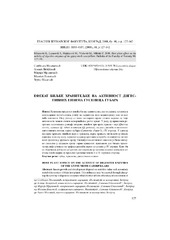Приказ основних података о документу
Efekat biljke hraniteljke na aktivnost digestivnih enzima gusenica gubara
Host plant effect on the activity of digestive enzymes of the gypsy moth caterpillars
| dc.creator | Milanović, Slobodan | |
| dc.creator | Lazarević, Jelica | |
| dc.creator | Mrdaković, Marija | |
| dc.creator | Vlahović, Milena | |
| dc.creator | Miletić, Zoran | |
| dc.date.accessioned | 2017-01-20T09:45:58Z | |
| dc.date.issued | 2008 | sr |
| dc.identifier.issn | 0353-4537 | sr |
| dc.identifier.other | Rad_konverzija_101 | sr |
| dc.identifier.uri | https://radar.ibiss.bg.ac.rs/handle/123456789/14 | |
| dc.description.abstract | Insect growth and development depend on nutritive value and secondary metabolite content of their host plants. This influence may be exerted through changing the activity of digestive enzymes which further affects efficiency of conversion of ingested food. This paper represents the results of investigation of feeding effects on the leaves of three oak species (Quercus cerris, Q. robur and Q. petraea) on growth, development and digestive enzyme activities of the 4th instar gypsy moth larvae (Lymantria dispar L.). Compared to larvae fed on Q. cerris and Q. robur leaves, larvae fed on Q. petrea exhibited the lowest body mass, midgut protein content and specific protease activity. Specific amylase activity was significantly reduced in the midguts of larvae fed on Q. robur while host plant did not affect larval duration upon molting into the 4th instar. Concomitant chemical analyses of leaves given to the 2nd and 4th instar larvae was carried out in order to explain the obtained results. | en |
| dc.description.abstract | Hranljiva vrednost lišća biljke hraniteljke, kao i sadržaj produkata sekundarnog metabolizma, utiču na parametre koji karakterišu rast i razviće insekata. Ovaj uticaj se može ostvariti preko enzima varenja od čije aktivnosti zavisi stepen iskorišćenja unete hrane. U radu su prikazani rezultati ispitivanja uticaja ishrane lišćem tri vrste hrasta - cer (Quercus cerris), lužnjak (Q. robur) i kitnjak (Q. petraea), na rast, razviće i aktivnost digestivnih enzima larvi gubara (Lymantria dispar L.) IV stupnja. U odnosu na larve hranjene lišćem cera i lužnjaka, larve hranjene kitnjakom su imale najmanju telesnu masu, najmanji sadržaj proteina i najveću specifičnu aktivnost proteaza u srednjem crevu. Specifična aktivnost amilaze je bila značajno smanjena u srednjem crevu larvi hranjenih lužnjakom dok biljka hraniteljka nije uticala na trajanje razvića larvi do ulaska u IV stupanj. Kako bi se objasnili dobijeni rezultati, istovremeno je vršena analiza hemijskog sastava lišća kojim su hranjene gusenice tokom II i IV larvenog stupnja. | sr |
| dc.description.sponsorship | Projekat ministarstva br. TR 20052 | sr |
| dc.language.iso | srp | sr |
| dc.rights | openAccess | sr |
| dc.source | Glasnik Šumarskog fakulteta | sr |
| dc.subject | gypsy moth | ENG |
| dc.subject | gubar | SRP |
| dc.subject | oaks | ENG |
| dc.subject | hrastovi | SRP |
| dc.subject | digestivni enzimi | SRP |
| dc.subject | digestive enzymes | ENG |
| dc.title | Efekat biljke hraniteljke na aktivnost digestivnih enzima gusenica gubara | sr |
| dc.title | Host plant effect on the activity of digestive enzymes of the gypsy moth caterpillars | en |
| dc.type | article | sr |
| dc.rights.license | ARR | |
| dcterms.abstract | Видаковић, Мелита; Ефекат биљке хранитељке на активност дигестивних ензима гусеница губара; Ефекат биљке хранитељке на активност дигестивних ензима гусеница губара; | |
| dc.citation.issue | 98 | sr |
| dc.citation.spage | 127 | sr |
| dc.citation.epage | 142 | sr |
| dc.type.version | publishedVersion | sr |
| dc.identifier.fulltext | https://radar.ibiss.bg.ac.rs//bitstream/id/2878/Rad_konverzija_101.pdf | |
| dc.identifier.rcub | https://hdl.handle.net/21.15107/rcub_ibiss_14 |

